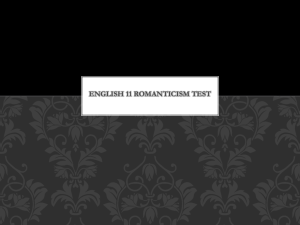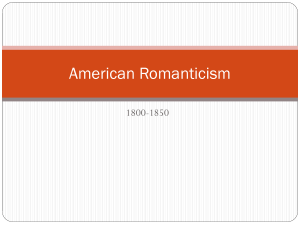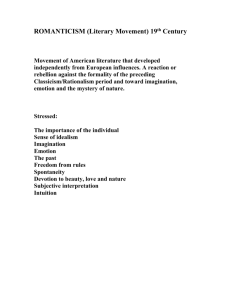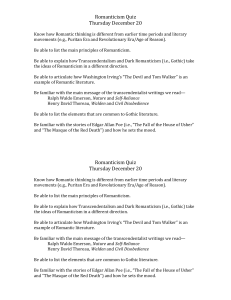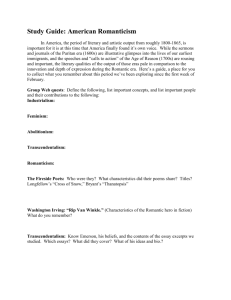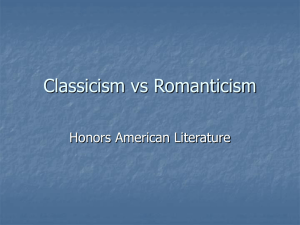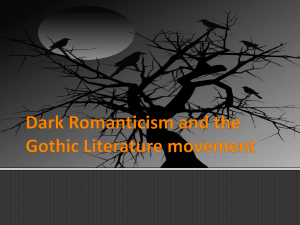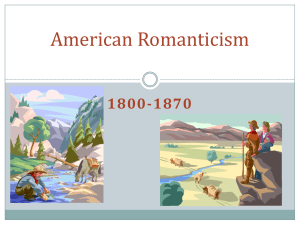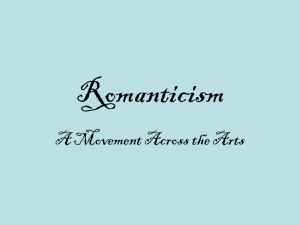Wed Thurs Jan 6 and 7
advertisement
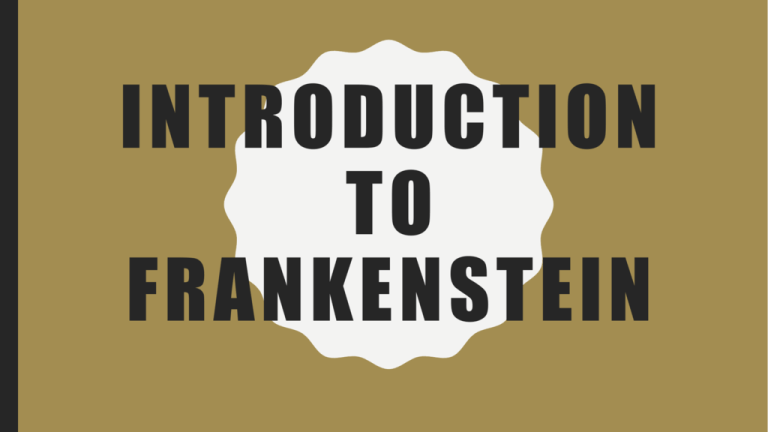
INTRODUCTION TO FRANKENSTEIN WARM-UP • What do you think the characteristics of Romanticism might be? What about the characteristics of Gothicism? ROMANTICISM A MOVEMENT ACROSS THE ARTS DEFINITION Romanticism refers to a movement in art, literature, and music during the 19th century. Reaction against the Age of Reason and industrialization. Romanticism is characterized by the 5 “I”s Imagination Intuition Idealism Inspiration Individuality IMAGINATION Imagination was emphasized over “reason.” This was a backlash against the rationalism characterized by the Neoclassical period or “Age of Reason.” Imagination was considered necessary for creating all art. British writer Samuel Taylor Coleridge called it “intellectual intuition.” INTUITION Romantics placed value on “intuition,” or feeling and instincts, over reason. Emotions were important in Romantic art. British Romantic William Wordsworth described poetry as “the spontaneous overflow of powerful feelings.” IDEALISM Idealism is the concept that we can make the world a better place. Idealism refers to any theory that emphasizes the spirit, the mind, or language over matter – thought has a crucial role in making the world the way it is. Immanuel Kant, a German philosopher, held that the mind forces the world we perceive to take the shape of space-and-time. INSPIRATION The Romantic artist, musician, or writer, is an “inspired creator” rather than a “technical master.” What this means is “going with the moment” or being spontaneous, rather than “getting it precise.” INDIVIDUALITY Romantics celebrated the individual Unique or odd Brave heroes Walt Whitman, a later Romantic writer, would write a poem entitled “Song of Myself”: it begins, “I celebrate myself…” THE DREAMER GASPAR DAVID FRIEDRICH, 1835 WHAT’S IT ALL ABOUT? Emotion Passion Irrationality VISUAL ARTS Neoclassical art was rigid, severe, and unemotional; it hearkened back to ancient Greece and Rome Romantic art was emotional, deeply-felt, individualistic, and exotic. It has been described as a reaction to Neoclassicism, or “anti-Classicism.” VISUAL ARTS: EXAMPLES Romantic Art Neoclassical Art MUSIC: COMPONENTS 1730-1820. 1800-1910. Classical music emphasized internal order and balance. Romantic music emphasized expression of feelings. https://www.youtube.com/watch?v=1ea90L91eZk https://www.youtube.com/watch?v=lLjwkamp3lI IT’S ABOUT: The Power & Majesty of Nature TURNER: “SHIPWRECK” LION WITH THE RABBIT - EUG È NE DELACROIX SUBLIME • Sensation of awe, often mixed with fear ROMANTICISM IS ALSO ABOUT: The Pitfalls of Science IT’S ABOUT: Nationalism AN OFFICER OF THE IMPERIAL HORSE GUARD THÉODORE GÉRICAULT, 1814 IT’S ABOUT: The Romantic Country Life FLATFORD MILL – JOHN CONSTABLE, 1817 THE DREAMER GASPAR DAVID FRIEDRICH, 1835 IT’S ABOUT: Romanticizing the Gothic and Medieval Life SALISBURY CATHEDRAL FROM THE MEADOWS JOHN CONSTABLE, 1831 GOTHICISM Gothic Architecture • Majestic, unrestrained architectural style • Profusion of savage, often grotesque ornamentation • Vaulting arches • Spires reaching to the heavens MODERN DAY EXAMPLES • What are some examples of more recent “Romantic” films, books, TV shows, and songs? • Example: The Lord of the Rings • Come up with 2-3 ideas in each category. Books Films TV Shows Music LITERATURE In America, Romanticism most strongly impacted literature. Writers explored supernatural and gothic themes. Writers wrote to express themselves. DARK ROMANTICISM • Reaction to the American Transcendental Movement, which some writers thought was too optimistic. – Transcendentalists believed in a perfect spiritual state that could be reached through intuition – Dark Romanticists adapted Transcendental ideas to fit their less positive views • Ex: Edgar Allen Poe, Emily Dickinson, Nathaniel Hawthorne, etc. DARK ROMANTICISM (CONT.) • Common beliefs include: – Humans are not inherently perfect; they are inclined towards wrongdoing. – Nature is a mysterious and sometimes evil spiritual force. – People may try to change the world, but they often fail. • Overlaps with Gothic fiction G O T H I C L I T E R AT U R E MOTIFS GOTHICISM Gothic Literature Developed as a genre in 18th century It is devoted to tales of horror, the darker, supernatural forces MADNESS • Reflects realities beyond rational comprehension • Mad characters speak truths we wish to deny THE DOPPELGANGER • A second self or alternate identity • Represents opposing forces in human nature • Suggests humans have a double nature • More Recent Example: Star Trek THE FAUST MOTIF: FORBIDDEN KNOWLEDGE OR POWER • Hero attempts to control supernatural powers • Ambition leads to fall TRAGIC HERO TRAITS... Hamartia: weakness that causes the eventual downfall; a fatal flaw Hubris: arrogance causing transgression against the gods; pride and overconfidence Catharsis: a move from ignorance to knowledge; release of emotions Peripeteia: reversal of fortune (fall from grace); unexpected reversal Nemesis: fate that cannot be escaped; poetic justice MONSTER/ SATANIC HERO/ FALLEN MAN • Fallen Hero becomes a Monster • Or, confronts a monster who is his double • Like Satan, he defies the rules of God’s universe • More Recent Example: Breaking Bad DEMONS/ DEVILS/ WITCHES/ ANGELS • Represent conflicting forces in the human soul • Hero may be tempted by evil spirits • Or, redeemed by good spirits • More Recent Example: Star Wars GRAVEYARDS / CHURCHES / RUINS • Suggest human confrontation with infinite forces • More Recent Example: Harry Potter 4 MULTIPLE NARRATIVE • Series of secret manuscripts or multiple tales • Narrative spirals inward to hidden truth • Narrator compelled to speak to captive listener • More Recent Example: “Found Footage” Movies PITCH YOUR STORY • Let’s say that you are a screenwriter who is trying to write and sell a script that falls under the genre of Romanticism, Dark Romanticism, Gothicism, or a combination. • What is the story? (1-2 paragraphs) • How does the story fit its genre? (1-2 paragraphs) MARY SHELLEY • https://www.youtube.com/watch?v=E4p96vqI3zA&list=FLhtAEOsRgD8G3ESHYXiBlMQ&index =6 MARY SHELLEY • When she was sixteen, she eloped with a poet named Percy Shelley. • Shelley and her husband eventually moved to Geneva, Switzerland, where they spent a large amount of time with another famous poet, Lord Byron. • While living there, the group engaged in a competition as to who could write the best ghost story. This competition led to the creation of Frankenstein. • The book was published anonymously in 1818. Reviews were mixed. • Mary Shelley died in 1851. CLOSURE • Summarize what you learned about Romanticism, Dark Romanticism, and Gothicism in three sentences.
